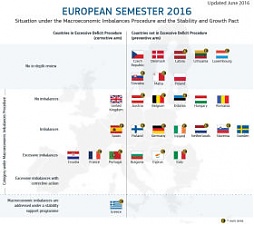Economics, EU – Baltic States, Modern EU
International Internet Magazine. Baltic States news & analytics
Thursday, 25.04.2024, 17:10
EU economic development through the surveillance mechanism
 Print version
Print version |
|---|
The Macroeconomic Imbalance Procedure (MIP) is a surveillance mechanism to detect and address economic trends that may adversely affect the proper functioning of a EU state, the countries in the euro area, or/and affecting the whole Union. MIP aims to identify potential risks on an early stage, prevent the emergence of harmful macroeconomic imbalances and correct the imbalances that are already in place.
MIP in action
The annual starting point of the MIP is the Alert Mechanism Report (AMR), which is based on a scoreboard of indicators. The AMR identifies countries for which a closer analysis (so-called, in-depth review) is deemed necessary. The outcome of these in-depth reviews forms the basis for further steps under the MIP whereby a graduated approach is followed reflecting the gravity of imbalances.
The Commission may propose that the Council issues recommendations to countries identified with imbalances. Countries for which imbalances are considered excessive would be subject to an enhanced process of specific monitoring or could enter the Excessive Imbalance Procedure, which can eventually lead to sanctions for euro area states in case of reiterated lack of compliance with obligations.
The 2016
in-depth reviews: results
Out of the 18
countries identified for an in-depth review (IDR) in the Alert Mechanism Report
(AMR) of 26 November 2015, 12 are deemed to experience imbalances. Bulgaria,
Croatia, France, Italy and Portugal remain in the excessive imbalances category
without triggering the Excessive Imbalances Procedure.
Finland, Germany, Ireland, The Netherlands, Spain, Sweden and Slovenia are found to experience imbalances. All EU states concerned by imbalances or excessive imbalances (without an Excessive Imbalances Procedure) will be subject to specific monitoring, adapted to the degree and nature of the imbalances presented. Austria and Estonia, which were subject to in-depth reviews for the first time this year, are deemed not to experience imbalances. For Belgium, Hungary, the UK and Romania, the procedure has been closed as the risks from imbalances have been reduced.
After exiting its financial adjustment programme on 31 March 2016, Cyprus was reintegrated into the regular cycle of European economic policy coordination, including the Macroeconomic Imbalance Procedure. The Commission adopted an in-depth review (IDR) for Cyprus on 7 April 2016. Cyprus is deemed to experience excessive imbalances, along with the five other EU states mentioned above.
 |
|---|
More information on the 2016 In-depth reviews
Alert Mechanism Report 2016The European Commission’s Alert Mechanism Report![]() (745 kB) kick starts the EU’s annual Macroeconomic
Imbalance Procedure. The AMR uses a scoreboard of indicators to screen for potential economic
imbalances that policymakers should address. Based on AMR results, countries
are selected for in-depth reviews (IDRs), where European Commission’s services
examine the existence or persistence of imbalances or their unwinding in the EU
states.
(745 kB) kick starts the EU’s annual Macroeconomic
Imbalance Procedure. The AMR uses a scoreboard of indicators to screen for potential economic
imbalances that policymakers should address. Based on AMR results, countries
are selected for in-depth reviews (IDRs), where European Commission’s services
examine the existence or persistence of imbalances or their unwinding in the EU
states.
In light of the results of the 2015 AMR, 18 countries were analysed in
IDRs.
MIP’s alert
mechanism
The MIP alert mechanism consists of an economic reading
of a scoreboard with 14 indicators
covering the major areas of macroeconomic imbalances and adjustment issues. The
aim of the alert mechanism is to act as a filter and identify for which
countries a more in-depth study into the risks of potential imbalances is
required.
The economic reading of the scoreboard indicators implies that there is no
automaticity in terms of conclusions (i.e. a "flash" for an indicator
does not lead to an automatic conclusion that there is a risk of an imbalance
that needs further investigation) and that any other relevant information is
also taken into account (which is explicitly expressed in the regulation and
supported by a large set of additional so called reading indicators).
The choice of indicators in the scoreboard focuses on the most relevant
dimensions of macroeconomic imbalances, competitiveness and adjustment issues.
For this reason, the scoreboard consists of indicators related to external
balances, competitiveness positions, internal imbalances and labour and social
adjustment issues.
Being an analytical tool, the scoreboard also has an important
communication role. Therefore the scoreboard consists of a limited number of
indicators. Moreover, the indicators and data transformations have been kept as
simple and straightforward as possible. Given that the scoreboard (indicators
and thresholds) need to provide signals of potentially harmful imbalances,
competitiveness and adjustment issues at an early stage, a combination of stock
and flow indicators which can capture both shorter-term rapid deteriorations as
well as the longer term gradual accumulation of imbalances have been chosen.
Finally, the main scoreboard is complemented by a large set of auxiliary
"reading indicators" that are used to better inform the screening
process.
· 3 year backward moving average of the current account balance as percent of GDP, with thresholds of +6% and -4% ;
· net international investment position as percent of GDP, with a threshold of -35%;
· 5 years percentage change of export market shares measured in values, with a threshold of -6%;
· 3 years percentage change in nominal unit labour cost, with thresholds of +9% for euroarea countries and +12% for non-euroarea countries;
· 3 years percentage change of the real effective exchange rates based on HICP/CPI deflators, relative to 41 other industrial countries, with thresholds of -/+5% for euroarea countries and -/+11% for non-euroarea countries;
· private sector debt (consolidated) in % of GDP with a threshold of 133%;
· private sector credit flow in % of GDP with a threshold of 14%;
· year-on-year changes in house prices relative to a Eurostat consumption deflator, with a threshold of 6%;
· general government sector debt in % of GDP with a threshold of 60%;
· 3-year backward moving average of unemployment rate, with a threshold of 10%;
· year-on-year changes in total financial sector liabilities, with a threshold of 16.5%;
· 3 years change in p.p. of the activity rate, with a threshold of -0.2%;
· 3 year change in p.p. of the long-term unemployment rate, with a threshold of +0.5%;
· 3 year change in p.p. of the youth unemployment rate, with a threshold of +2%.
The economic reading takes into account complementary additional indicators, as stipulated in Article 4.4 of Regulation (EU) No 1176/2011 and outlined in the Alert Mechanism Report. The list of 'scoreboard' and additional indicators was drafted and is regularly reviewed jointly with Member States and the ECB in the context of LIME, a working group of the Economic Policy Committee.
Additional information: = Scoreboard data platform: Interactive database of the scoreboard and its 'auxiliary' indicators, latest and previous official releases by the Commission, as well as latest 'live' data for the scoreboard indicators (Eurostat); and = Statistical Annex of the Alert Mechanism Report: data on scoreboard and additional indicators Reference documents:
· Alert Mechanism Report 2016: the economic reading of the scoreboard and recommendations for in-depth reviews (26 Nov 2015);
· Adding employment indicators to the MIP scoreboard to better capture employment and social developments (4 Sept 2015);
·
Completing the
Scoreboard for the Macroeconomic Imbalance Procedure ![]() Financial Sector Indicator.
(14 Nov 2012);
Financial Sector Indicator.
(14 Nov 2012);
·
Scoreboard for
the surveillance of macroeconomic imbalances: technical explanations
on the scoreboard (Feb 2012);
·
Views of the European Systemic Risk
Board (ESRB) on the Envisaged Scoreboard Indicators Relevant for Financial
Market Stability (9 Dec 2011);
·
Regulation (EU)
No 1176/2011 of 16 November 2011 on the prevention and correction of
macroeconomic imbalances (16 Nov 2011);
·
Scoreboard for
the surveillance of macroeconomic imbalances ![]() : envisaged initial design
(8 Nov 2011);
: envisaged initial design
(8 Nov 2011);
·
Council
conclusions on an early warning scoreboard for the surveillance of
macroeconomic imbalances ![]() (8 Nov 2011).
(8 Nov 2011).








 «The Baltic Course» Is Sold and Stays in Business!
«The Baltic Course» Is Sold and Stays in Business!

